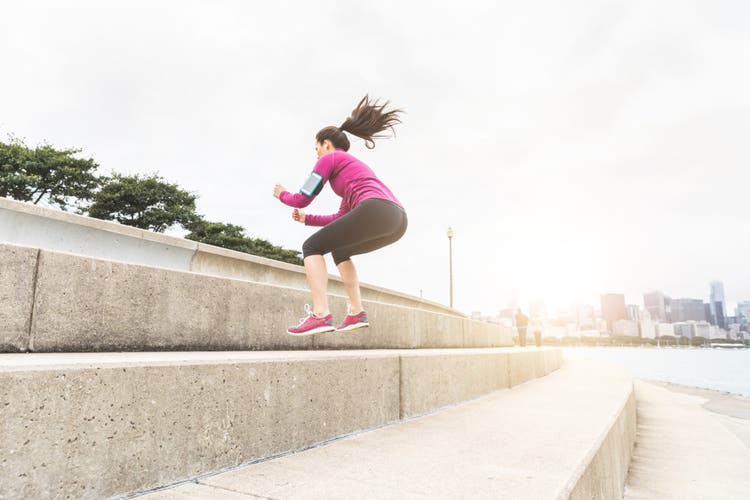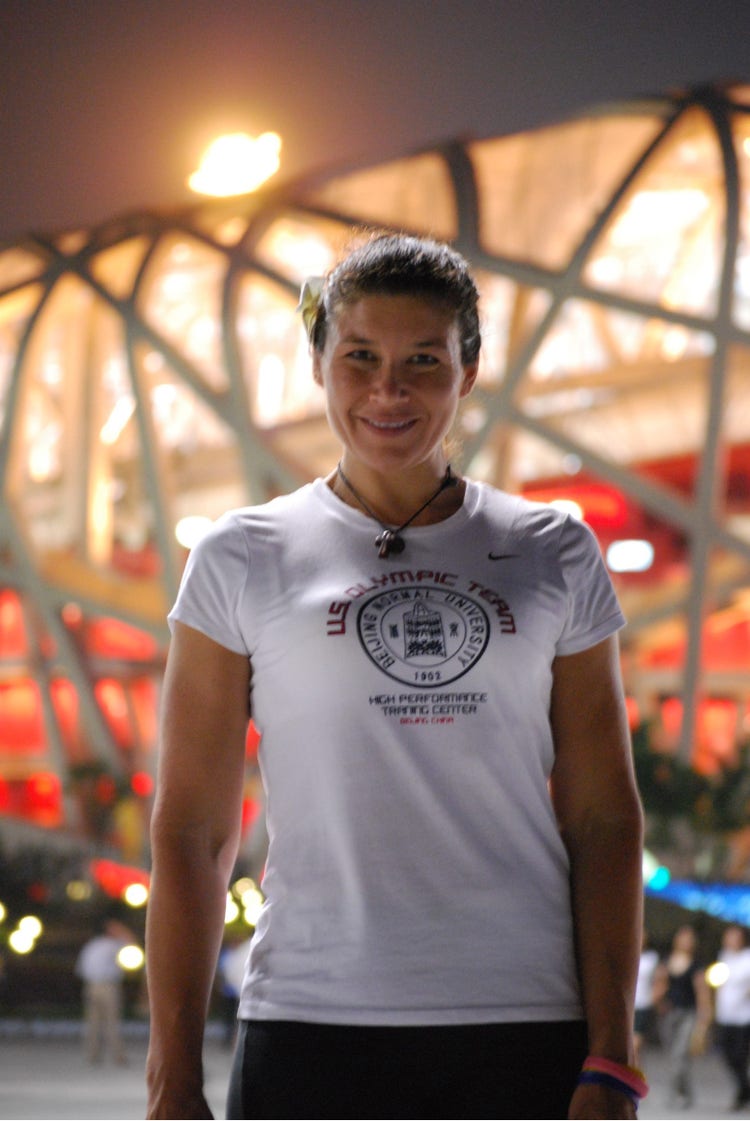A Personal Trainer on Getting Race-Day Ready and Total-Body Cardio Moves

Looking for workouts that get your blood pumping? Worried about high blood pressure and working out? Training for a race and hate the treadmill?
We put these and other burning questions from readers to 24 Hour Fitness Hawaii master trainer Lisa Martin. She has been with the company for two decades, has trained more than 29,000 sessions and is a U.S. Olympic Committee-certified trainer.

24Life: What are some workout moves I can do that will get my blood pumping and my whole body involved?
Lisa Martin: When I work with my clients, I like to start with basic movement patterns and build on these once the base moves are solid.
Squats, push-ups, rows, shoulder presses, pull-ups and planks are all amazing base moves I like to incorporate into a training program. These moves can stand alone or become the foundation for more advanced movements. Once a client has mastered the base moves, I introduce Olympic lifts, compound movements and plyometrics. Although Olympic lifts can be daunting to some, these movements are very straight forward, get your whole body involved and are an excellent way to get your heart pumping! Current research indicates that Olympic lifts increase strength, power and speed better than other modes of exercise. Also strength and power are key not only in athletic development, but also in helping us live longer, stronger and healthier lives.
If you do not have the joint stability needed to progress to Olympic moves or if you just want more variety, there are several compound movements you can do. I like incorporating squat/press, inchworms with a push-up, squat/rows and burpees with a push-up/squat jump into workouts. These compound movements will give you a high-intensity workout in a short amount of time.
Ultimately, there are many great movements you can do to get your heart pumping and your entire body involved. I have only highlighted a few. The most important element of your workout regime is to complete your workouts in good form while maintaining your target heart rate to achieve your personal goals.
24Life: I have really high blood pressure—how can personal training/working out help me, and how can I do it in a safe and healthy way?
LM: If you have really high blood pressure, seeking the expertise of a trained professional is the best way to help you get healthy. Start by consulting your doctor before you begin working out, and have him or her sign a physician’s release for you. This is a great opportunity for your doctor to detail any limitations he or she has for you, including a maximum target/training heart rate. The type of medication you are on will affect how we monitor your workouts, so having open communication with your doctor is key to training in a safe and healthy way. A personal trainer can safely guide you through the process.
I always encourage my clients to purchase a heart rate monitor. Although this does not measure blood pressure, it does help me monitor your heart rate during our workout. You can also wear your monitor after our sessions and note any changes. Several of my clients know from personal experience, I can and will tell them to make an appointment with their doctor if I don’t like how their hearts are responding to our workouts!
Having high blood pressure does not mean you cannot exercise. In fact, light to moderate exercise can help reduce blood pressure and can also help you lose weight, manage stress and strengthen your heart—all of which can also lead to lower blood pressure. The key is moderation, working in the heart rate range that is best suited for your personal needs and incorporating dynamic resistance moves that help to work your total body without placing you in a position to compromise your health.
24Life: My trainer took me through a workout, but I don’t feel like I worked that hard. What should I do?
LM: If I am correct, it sounds like you are not happy about the direction your workouts are going. I suggest having a “sit down” with your trainer to talk about your expectations. Hopefully during your first session with your trainer, you were able to discuss your medical history and current physical situation as well as your goals, expectation and preferences on workout styles. If not, there is no time like the present!
I like to have an open communication system with my clients. They have chosen to spend their time and money working with me. It is an honor and a privilege for me to help guide them along their fitness journey. If they are happy with what we are doing, I want to know. Likewise, if they want to go in a different direction, I also want to know. Sometimes my clients are not physically ready to do the workout they envision themselves doing. My role as a trainer is to not only put them through a workout, but to do it in a safe and efficient manner. Some workouts might be lower intensity but are conducted with the intention of building a foundation so that they are able to complete the movements they told me they want to be able to do!
I tell my clients from the get go to let me know if there are movements they want to incorporate into our sessions. If I believe they are ready for a move, I will show them how to safely add it in. If they are not ready I will let them know, but I will also integrate moves into their workouts to prepare them for the ones they ultimately want to do.
Over the years, some clients have asked me to “make them sore.” Although many people believe the sign of a “good” workout is being so sore you can barely move the next few days, this is the exact opposite of what I want. Some delayed onset muscle soreness (DOMS) is natural; however, extreme muscle soreness after a workout tells me that the intensity of the exercises selected was too much for the individual or the movements were too advanced. Extreme muscle soreness after a workout is a sign that your muscles have been injured. My goal while introducing new movements and intensities is to challenge my clients in moderation so that they feel worked out, but are still able to comfortably function in the days following our workout.
That said, there might be a reason why your trainer designed a workout that was not as high-intensity as you wanted. Talk to your trainer and ask why he or she designed the workout he or she did, and reiterate what drives, motivates and inspires you.
24Life: I’m training for a race—what are some things I can do to prepare for my race that are not running on a treadmill?
LM: Anyone who has trained to run a marathon or half marathon knows from experience that it is important to get miles in on the road. One thing not everyone knows is how important it is to add resistance/strength/power training days, recovery days and flexibility/myofascial release days into your workouts, too.
I personally urge my clients to limit their runs to three times per week with one long run, one recovery run and one short sprint or hill run. Early on in your training when your total miles are lower, I would instruct you to do resistance (i.e. machines, free weights, kettlebells, TRX or Olympic moves) on three of your non-running days and at least one to two days of an alternate form of cardio (bike, elliptical, stepper or rower) also on your non-running days. As you get closer to race day and your total miles on the road are higher, I would have you reduce both the intensity and frequency of your resistance (two days per week) and limit your alternate form of cardio to once a week. The day after your long run is a recovery day where I will instruct you to do a little foam rolling or other form of myofascial release. Alternatively, you could take a yoga class, get a massage or even do some pool walking. Some of my clients like to go for a nice walk with their families on that day. It’s a day meant to allow your muscles to release and lengthen.
24Life: I want to improve my speed. What workouts or what type of training should I do to get there?
LM: More and more research has been compiled lately linking Olympic movements to increased rates of force production—meaning people who incorporate Olympic movements into their workouts not only have more strength and power, but they also have more speed. That said, a great way for you to increase your speed is to start adding Olympic movements into your workout. There are United States Olympic Committee-certified trainers in most 24 Hour Fitness clubs across the country who can show you how to start incorporating Olympic movements into your workout. Even the base exercises we use to assess your core strength and joint flexibility can help your get stronger and faster!
Lisa Martin has been a personal trainer at 24 Hour Fitness for more than 20 years. She is a U.S. Olympic Certified Trainer and Master Trainer. She has also earned her Sports Performance Specialist, Performance Exercise Specialist, Corrective Exercise Specialist and Optimal Performance Certifications through NASM. Additionally, she is a certified TRX instructor and USA Weightlifting Level 1 Sport Performance Coach. Lisa has trained more than 29,000 personal training sessions in her time with 24 Hour Fitness, and works at the Windward Active club in Hawaii.
Photo credit: william87, Adobe Stock; Courtesy of Lisa Martin